 View Detailed 10 Day Weather Forecast for Groningen, at Weather-Forecast.com
View Detailed 10 Day Weather Forecast for Groningen, at Weather-Forecast.com
Below are a few sites with interesting information on the weather,
concerning both the current situation and archives. Most are in Dutch.
Click here for
more detailed information on the meteorological conditions in the
Netherlands; also available is the site of the official Dutch
meteorological service KNMI, which has the current weather
and related information. Other excellent Dutch sites with much information
are weersite.net and
weersite.nl.
For information in English click here.
Click for the weather forecast for Groningen from the World Meteorological Organization
or the Weather Channel
or for the Netherlands from the Microsoft Network MSN.
You can find here also a radar map
of rain
in the Netherlands.
Here are weather statistics for the Netherlands for
the current
month and
the archival data.
The part of the Netherlands, where I live, has the following
weather characteristics:
The monthly averaged minimum temperature varies from -0.1 C
in February to 12.5 C in July and the monthly averaged
maximum temperature from 5.1 C in
January to 21.9 C in August. There are on average 4 days
per year when the temperature
gets above 30 C and 8 when the temperature does not get above 0 C. The sun
shines 1602 hours per year, which is 36.6% of the available time.
There are per year on average 80 days without any sunshine and 29 when
the sun shines for more than 80% of the available time. The annual
precipitation is 883 mm and the total duration is 667 hours, which is
7.6% of the time. There are on average 165 days per year without
any precipitation and 136 with 1 mm or more.
All of this of course is quite typical for northern Europe.
The current sea and land temperatures and cloud cover
are (if it does not update click it)
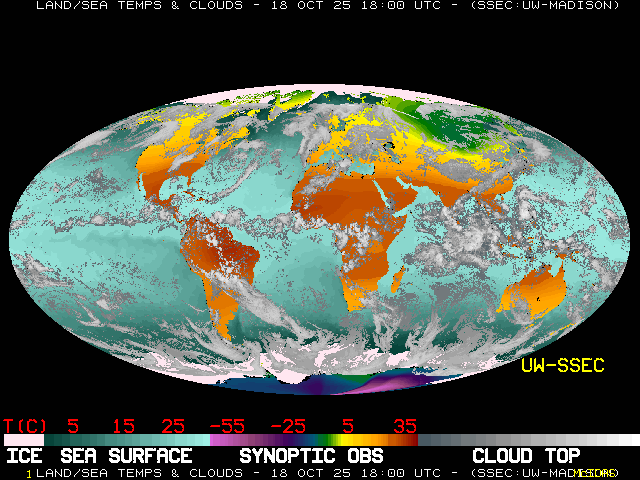
There is also a
movie
of these images over the last week or so.
Worldwide highest temperatures for
today can be found here
.
The temperatures in Europe over the last 24 hours
are shown in the following animation
(if it does not show click the little square; if it does not
update click the frame)

Back to contents
Back to top of page
Sun, Moon, planets, sky and time

Here are some useful links with astronomical information:

Today's position, times
of rising and setting
for the
Sun, and times of
twilight, etc. in
the Netherlands,
and an advanced
calculator.

Today's position of the
Moon
on the sky, its
phase and additional information. Here is a listing of
Moon phases.

The data for the
planets
and a current
map of the Solar System.

Information in Dutch on observable occurences on the sky over the
next few weeks are listed on the site of
Govert
Schilling.
A comprehensive site in English is that of
Sea & Sky.

The
sky at this time
as seen from Amsterdam.

The
Mag-7 Star
Atlas Project of
Cloudy Nights
provides beautiful atlas of the sky.

The Website of the
U.S. Naval Observatory can be
consulted for all kinds of astronomical information, including rising and
setting of Sun and Moon, twilights, moonphases, eclipses and transits, and
much more.

Fred Espenak at JPL maintains a nice site with information on past and
future solar and lunar
eclipses.

A very useful site with much information on time, weather, sunrise, sunset, etc. is
time and date. You
can find there
the current time
for most countries and their capitals; this site also has
calenders
for different countries and years. Accurate clocks are available that
show the current
Greenwich Mean Time
from the UK and
Universal Time
from the USA. You should not be able to detect any difference. Another useful
site is
calendar-365.
 Click
on the picture for an up-to-date day/night picture of
the Earth (and many related interesting features)
Click
on the picture for an up-to-date day/night picture of
the Earth (and many related interesting features)

This day/night picture applies to the equinox at local
mean solar time 12:00 at Groningen (longitude 6.550 degrees East;
latitude 53.217 degrees North). Here you can see the pictures at the (northern hemisphere)
summer
and winter
solstices.
The civil time in the Netherlands
is Central European, corresponding to the meridian of
15 degrees East. The longitude correction for Groningen with respect to that
meridian is +33.8 minutes. In the spring (20 March) the
Equation of Time
is -7.3 minutes (of time), so noon in
local mean solar time corresponds to 12:26:30 Central European
Standard Time or 11:26:30 Universal Time (UTC). In the fall
(22 September) the Equation of Time is +7.4 minutes, so the corresponding
times are 13:41:12 Central European Daylight-saving Time and 11:41:12
UTC.
The equation of time is one aspect that determines the form of the analemma.
Back to contents
Back to top of page
Publications and presentations
Scientific publications
It is possible to get a list of my papers that are
present on the preprint server
Astro-ph.
The
NASA Astrophysics Data System
(ADS)
maintains an electronic list of essentially all astronomical literature.
It provides for recently published papers links to electronic versions of
the scientific journals, but you need an electronic subscriptions to access
these papers. Papers and reviews in journals and contributions to many
proceedings published before 1999 (or so) have all been
scanned and are available through ADS and are available without charge.
The ADS can select and order publications in various ways, but not always
correctly. In particular book reviews, errata and unrefereed contributions
to conference proceedings are added to such lists when they appear in refereed journals.
Below are links to my papers, ordered and selected in various ways.
 Refereed
Refereed papers ordered by year of publication.
 Refereed papers ordered by the number of
citations
Refereed papers ordered by the number of
citations received.
 Non-refereed
Non-refereed papers ordered by year of publication.
 All
All papers ordered by number of citations.
My papers since 1999, that are not available in scanned versions through ADS,
can be obtained in pdf-format directly
here.
Papers before 1999 that are not available through ADS can be found there as
well.
Back to contents
Back to top of page
Inaugural and valedictory lectures
 For those who read Dutch there is a copy of my "inaugural lecture" at the University
of Groningen at the occasion of my appointment as full professor per
June 1, 1987, entitled
`Welke
ster is nu de mijne?' and
delivered on Januari 26, 1988.
For those who read Dutch there is a copy of my "inaugural lecture" at the University
of Groningen at the occasion of my appointment as full professor per
June 1, 1987, entitled
`Welke
ster is nu de mijne?' and
delivered on Januari 26, 1988.,

My "
valedictory lecture" at the University
of Groningen was delivered on October 12, 2009 at the end of the symposium
Challenges,
held at the occasion of my retirement. It is partly in English, partly in
Dutch and has the title
`It all
started with Kapteyn'. There is also a
booklet version.
Back to contents
Back to top of page
Stellar Populations Symposium
 The
proceedings of IAU Symposium 164 on ``Stellar Populations'' (1994),
edited by P.C. van der Kruit and G.
Gilmore, have been reprinted and revised in Volume
267
of Astrophysics and Space Science (2000).
Here is the preface.
Back to contents
Back to top of page
The
proceedings of IAU Symposium 164 on ``Stellar Populations'' (1994),
edited by P.C. van der Kruit and G.
Gilmore, have been reprinted and revised in Volume
267
of Astrophysics and Space Science (2000).
Here is the preface.
Back to contents
Back to top of page
Kapteyn Legacy Symposium
 The Legacy of J.C. Kapteyn: Studies
on Kapteyn and the Development of Modern Astronomy, edited
by P.C. van der Kruit and K. van Berkel. This are the proceedings
of a symposium organized by Klaas van Berkel and myself at the occasion of the
385th anniversary of the University of Groningen in 1999.
The Legacy of J.C. Kapteyn: Studies
on Kapteyn and the Development of Modern Astronomy, edited
by P.C. van der Kruit and K. van Berkel. This are the proceedings
of a symposium organized by Klaas van Berkel and myself at the occasion of the
385th anniversary of the University of Groningen in 1999.
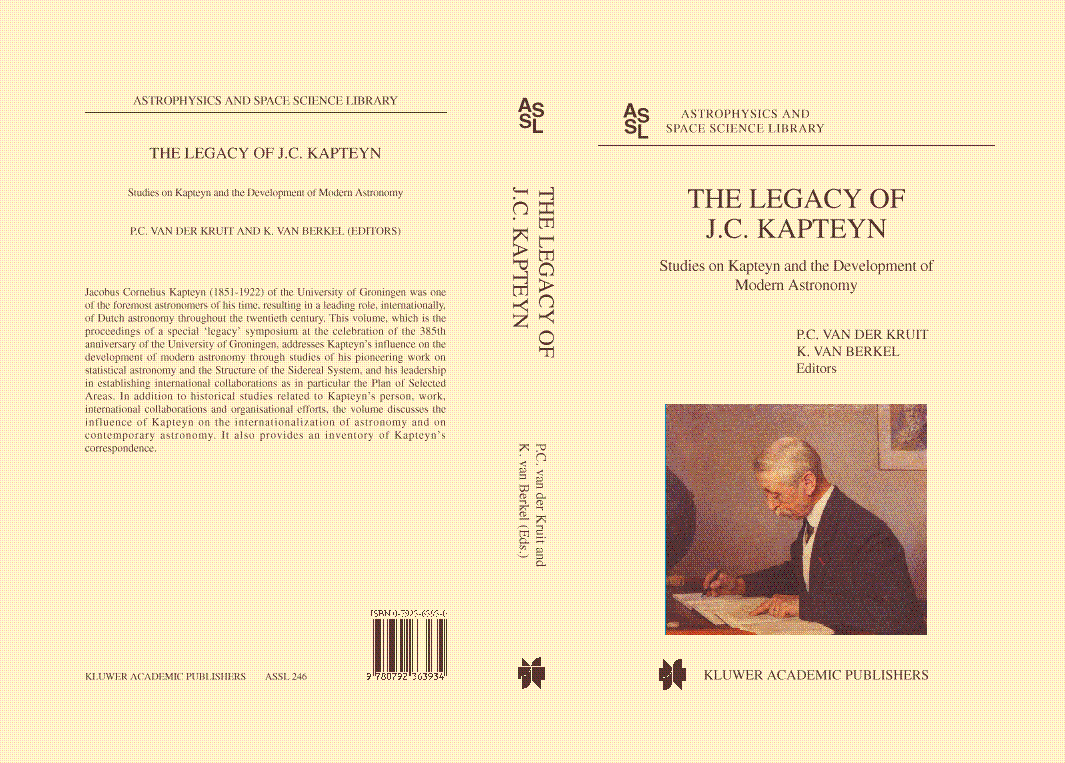
Here are the
title page,
contents and preface .
Back to contents
Back to top of page
Selected presentations of scientific talks
 Structure
and dynamics of disks , invited review at
``The Dynamics, Structure & History of Galaxies'',
a workshop at the occasion
of Ken Freeman's 60-th birthday, Dunk Island, Queensland,
Australia, July/August 2001.
Structure
and dynamics of disks , invited review at
``The Dynamics, Structure & History of Galaxies'',
a workshop at the occasion
of Ken Freeman's 60-th birthday, Dunk Island, Queensland,
Australia, July/August 2001.
 The
stars and gas in outer parts of galaxy disks - Extended or truncated,
flat or warped? , invited review at
``Formation and Evolution of Galaxy Disks'',
Vatican Symposium, Rome, Italy, October 2007.
The
stars and gas in outer parts of galaxy disks - Extended or truncated,
flat or warped? , invited review at
``Formation and Evolution of Galaxy Disks'',
Vatican Symposium, Rome, Italy, October 2007.
 The
masses of disks , invited review at
``Unveiling the Mass'',
in honor of Vera Rubin's 80th birthday; Kingston, Canada, June 2009.
The
masses of disks , invited review at
``Unveiling the Mass'',
in honor of Vera Rubin's 80th birthday; Kingston, Canada, June 2009.
 Structure,
mass and stability of galactic disks , invited review at
``Galaxies and their Masks'',
in honor of Ken Freeman's 70th birthday; Sossusvlei, Namibia, April 2010.
Structure,
mass and stability of galactic disks , invited review at
``Galaxies and their Masks'',
in honor of Ken Freeman's 70th birthday; Sossusvlei, Namibia, April 2010.
 Truncations
in stellar disks and warps in the HI layers in spiral galaxies ,
colloquium given at a number of places, most recently (Sept/Oct 2011) at
the National Astronomical Observatory of China in Beijing and
the Shanghai Astronomical Observatory in Shanghai, China.
Truncations
in stellar disks and warps in the HI layers in spiral galaxies ,
colloquium given at a number of places, most recently (Sept/Oct 2011) at
the National Astronomical Observatory of China in Beijing and
the Shanghai Astronomical Observatory in Shanghai, China.
 Truncations
and warps in disks of spiral galaxies ,
Invited review given in various forms at symposia in Naples, Italy
(September 2013), Flagstaff, Arizona (October 2014) and Sydney, Australia
(November 2014).
Truncations
and warps in disks of spiral galaxies ,
Invited review given in various forms at symposia in Naples, Italy
(September 2013), Flagstaff, Arizona (October 2014) and Sydney, Australia
(November 2014).
 Jacobus
C. Kapteyn (1851-1922): Born investigator of the Heavens , Invited review
at the Seychelles (May 2014) and
colloquium given at a number of places, most recently at the Carnegie
Observatories in Pasadena, California (October 2014) and Mount Stromlo
Observatory, Canberra, Australia (November 2014).
Back to contents
Back to top of page
Jacobus
C. Kapteyn (1851-1922): Born investigator of the Heavens , Invited review
at the Seychelles (May 2014) and
colloquium given at a number of places, most recently at the Carnegie
Observatories in Pasadena, California (October 2014) and Mount Stromlo
Observatory, Canberra, Australia (November 2014).
Back to contents
Back to top of page
Citation analysis
 A comparison
of astronomy in fifteen member countries of the
Organisation for Economic Co-operation and Development
P.C. van der Kruit, Scientometrics 31, 155-172 (1994).
A comparison
of astronomy in fifteen member countries of the
Organisation for Economic Co-operation and Development
P.C. van der Kruit, Scientometrics 31, 155-172 (1994).
 The astronomical
community in the Netherlands
P.C. van der Kruit, Quarterly Journal of the Royal
Astronomical Society 35, 409-423 (1995).
The astronomical
community in the Netherlands
P.C. van der Kruit, Quarterly Journal of the Royal
Astronomical Society 35, 409-423 (1995).
 Citation
analysis and the NASA Astrophysics Data System (ADS)
P.C. van der Kruit (2005).
Citation
analysis and the NASA Astrophysics Data System (ADS)
P.C. van der Kruit (2005).
 Citations
and impact of Dutch astronomy
P. Kamphuis and P.C. van der Kruit (2010).
Back to contents
Back to top of page
General articles
Citations
and impact of Dutch astronomy
P. Kamphuis and P.C. van der Kruit (2010).
Back to contents
Back to top of page
General articles
The following are in English:
 The
Recruitement to Science and Engineering Courses
in the Netherlands (1997)
The
Recruitement to Science and Engineering Courses
in the Netherlands (1997)
 Man's
Place in the Universe (1994)
Man's
Place in the Universe (1994)
 Ranking
of national soccer teams (1998)
Ranking
of national soccer teams (1998)
 Safety in
transport and traffic (2001)
Safety in
transport and traffic (2001).
This a response to a column
by Karel Knip in the national newspaper NRC/Handelsblad. Hier zijn (in
Dutch) de
oorsponkelijke column, mijn
respons
and Knip's
reactie in een latere column.
 Home
advantage and tied games in soccer
(2006)
Home
advantage and tied games in soccer
(2006)
The following are in Dutch:
 Astronoom
van beroep (oorspronkelijk
gepubliceerd in 1987 in `Zenit')
Astronoom
van beroep (oorspronkelijk
gepubliceerd in 1987 in `Zenit')
 Harmonie (1993)
Harmonie (1993)
 Jacobus
Cornelius Kapteyn Academische Boekengids (1999)
Jacobus
Cornelius Kapteyn Academische Boekengids (1999)
 Sturing
van Wetenschappelijk Onderzoek (1998)
Sturing
van Wetenschappelijk Onderzoek (1998)
 Tijd
(2001)
Tijd
(2001)
 Stonehenge (2001)
Stonehenge (2001)
 Kan
de mens niet 100, maar 100.000 jaar overleven?, bespreking van
Surviving 1000 centuries: can we do it?, van Roger Bonnet & Lodewijk Woltjer
voor de Academische
Boekengids (2009)
Kan
de mens niet 100, maar 100.000 jaar overleven?, bespreking van
Surviving 1000 centuries: can we do it?, van Roger Bonnet & Lodewijk Woltjer
voor de Academische
Boekengids (2009)
 Dan
zouden we het toch gehoord hebben?, bespreking van zes boeken over
intelligent leven in het heelal en exoplaneten
voor de Academische
Boekengids (2010)
Dan
zouden we het toch gehoord hebben?, bespreking van zes boeken over
intelligent leven in het heelal en exoplaneten
voor de Academische
Boekengids (2010)
 Radioruis
en de kosmos, bespreking van drie boeken over de geschiedenis van
de radiosterrenkunde, kosmologie en kosmische achtergrondstraling
voor de Academische
Boekengids (2011)
Back to contents
Back to top of page
Radioruis
en de kosmos, bespreking van drie boeken over de geschiedenis van
de radiosterrenkunde, kosmologie en kosmische achtergrondstraling
voor de Academische
Boekengids (2011)
Back to contents
Back to top of page
Publieke lezingen/Popular lectures
In het Nederlands:
 De
witte netten van zon en maan (2001).
De
witte netten van zon en maan (2001).
 Neem
nou het heelal (2007).
Neem
nou het heelal (2007).
 De
Ster van Bethlehem: Mogelijke astronomische verklaringen (2011).
In English:
De
Ster van Bethlehem: Mogelijke astronomische verklaringen (2011).
In English:
 The
Star of Bethlehem (1993).
The
Star of Bethlehem (1993).
 2009:
the International Year of Astronomy. Lecture held for the Koninklijk Natuurkundig Genootschap,
January, 2009.
2009:
the International Year of Astronomy. Lecture held for the Koninklijk Natuurkundig Genootschap,
January, 2009.
 Intelligent Life in the Universe:
Crowded skies, lonely planet or rare Earth?. Lecture held for the Koninklijk Natuurkundig Genootschap
on November 15, 2011.
Back to contents
Back to top of page
Intelligent Life in the Universe:
Crowded skies, lonely planet or rare Earth?. Lecture held for the Koninklijk Natuurkundig Genootschap
on November 15, 2011.
Back to contents
Back to top of page
J.H. van Oosbreelezing
In 2008 ben ik uitgenodigd de
tiende J.H. van Oosbreelezing
te houden. De lezing is gehouden op 5 april te Amersfoort onder de titel
"OORSPRONG:
Over mens en heelal, wetenschap en religie,
samenhang en toeval, de weg en de herberg".
Hier zijn respectievelijk
 De omslag
van het boekje, uitgegeven door
Eburon.
De omslag
van het boekje, uitgegeven door
Eburon.
 De beamer
presentatie.
De beamer
presentatie.
 Een
uitgebreide (XXL)
versie van het boekje (ook beschikbaar in `booklet-printing'
format met grotere letter; print dubbelzijdig op A4 met optie duplex=short edge
en snij middendoor).
Een
uitgebreide (XXL)
versie van het boekje (ook beschikbaar in `booklet-printing'
format met grotere letter; print dubbelzijdig op A4 met optie duplex=short edge
en snij middendoor).
 Tijdens de lezing vertoonde ik de film
Cosmic Voyage,
waarvan delen te zien zijn op het
Web.
Tijdens de lezing vertoonde ik de film
Cosmic Voyage,
waarvan delen te zien zijn op het
Web.
Back to contents
Back to top of page
ESO Council
Between summer 2000 and end of 2005 I was Netherlands delegate and later
President of the Council of the
European Southern Observatory with an extra year
in 2006-2007.
I have written down my experiences in
Five-and-a-half
years in ESO Council.
This is a text written for a public that does know little about the European
telescopes in Chile.
Back to contents
Back to top of page
Vijf Jaar voor Beta's
De noodzaak
van een vijfjarig curriculum voor de beta-opleidingen
aan de algemene universiteiten.
 Rapport
van de Commissie Vijfde Jaar Beta Studies (juni
1997), waarvan ik voorzitter was, op grond waarvan
de minister uiteindelijk een vijf-jarig curriculum heeft
goedgekeurd.
Back to contents
Back to top of page
Rapport
van de Commissie Vijfde Jaar Beta Studies (juni
1997), waarvan ik voorzitter was, op grond waarvan
de minister uiteindelijk een vijf-jarig curriculum heeft
goedgekeurd.
Back to contents
Back to top of page
Lecture courses
 Inleiding Sterrenkunde
This is an introductory course on astronomy that I gave to first year students
in Dutch in the years 1975-1982, 1984-1991 and 1998-2002. It developed in the
course of time and here are the viewgraphs (in Dutch) of the course in the
final year 2002.
Inleiding Sterrenkunde
This is an introductory course on astronomy that I gave to first year students
in Dutch in the years 1975-1982, 1984-1991 and 1998-2002. It developed in the
course of time and here are the viewgraphs (in Dutch) of the course in the
final year 2002.
Transparanten van de colleges:
1.
Positionele sterrenkunde; aardafplatting
2.
Het planetenstelsel; twee-lichamen probleem
3.
Helderheid, temperatuur, classificatie en massa van sterren; Hertzsprung-Russell diagram
4.
Vorming van sterren
5.
Evolutie van sterren
6.
Eindstadia van sterren
7.
Afstandsbepaling en interstellaire materie
8.
Structuur en dynamica van ons Melkwegstelsel
9.
Melkwegstelsels
10.
Kosmologie
11.
Waarom is het 's nachts donker?
Het boek bij het college (bruikbaar als achtergrond
materiaal; niet voor definitie of tentamenstof) is

De tentamenstof is gedefinieerd aan de hand van de transparanten
en deze
tekst . Tentamenstof en antwoorden van
26
juni 2000, 2
juli 2001 en 1
juli 2002.
Back to contents
Back to top of page
 Structure
of Galaxies (Structuur van melkwegstelsels).
Structure
of Galaxies (Structuur van melkwegstelsels).
This course evolved from an introductory course on galaxies that I first
set up in the late seventies together with Ron Allen and Ron Ekers and which
I have given by myself since about 1980 until 2002 mostly in a two-year cycle.
It has also been the basis of my part of the
Saas-fee course "The Milky Way as a Galaxy",
that I gave in 1989 together with Ivan King and Gerry Gilmore. I have given
the course also at a number of occasions as one-week lecture
series: twice as part of
the NOVA fall-school, once for students from Bochum University,
at the University of Porto, Portugal (this year for the fourth time) and
once at ESO-Vitacura in Santiago, Chile.
To the
written documentation with the course belong
this background document with references, definition of the
material for the exam and two exersizes, plus additional background
papers summarizing the theories of Galactic
Dynamics and Chemical
Evolution. (Versions with larger characters for booklet printing are
here
and here.)
In earlier times the exam consisted partly of presentations by students discussing
recent professional publications on related research and for this
I prepared a set of Hints
on presenting papers. This is from the early nineties, when presentations
were done using overhead projectors, so much is out of date.
The
viewgraphs of this course were in English.
These
were available as .pdf files
and the full set of the lectures up to 2006 are available as
a single zipped tar-file here.
The course was revised and updated in early 2007 for the series of
lectures in Santiago and Porto and changed into beamer presentations.
The most recent individual
chapters are:
1.
Structure, kinematics and dynamics of the Galaxy
2.
Stellar Populations, classification, surface photometry
3.
Luminosity distributions and component analysis
4.
Photometric parameters and evolution
5.
Kinematics of galaxies
6.
Dynamics of galaxies
7.
Structure of galaxy disks
8.
Absorption, chemical evolution
9.
Elliptical galaxies
10.
Formation of galaxies
The course uses the textbooks
(useful to have as background material):
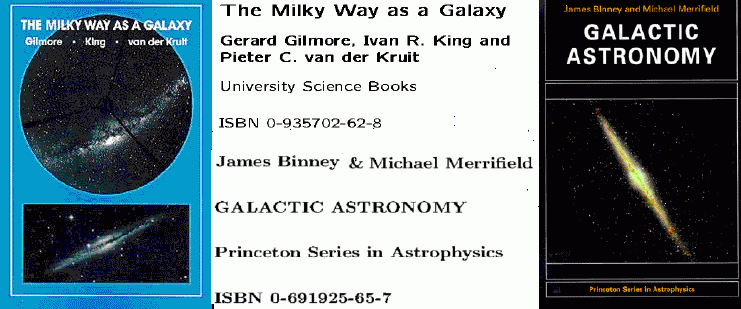
My chapters in "The Milky Way as a Galaxy" are
available as .pdf files in a different lay-out then
the original publication:
Ch. 5:
Photometric components in disk galaxies
Ch. 10:
Kinematics and mass distributions in spiral galaxies
Ch. 12:
The distribution of properties of galaxies
Ch. 14:
Chemical evolution and disk galaxy formation
Ch. 15:
The Milky Way in relation to other galaxies
Hier
zijn de tentamen opgaven van 12
maart 1999, 19
maart 2001 en 2
december 2002 .
Back to contents
Back to top of page
 Enige
jaren heb ik in het college Evolutie van Prof. van
Delden aan biologen twee colleges gegeven over Kosmische evolutie. De bijbehorende
transparanten zijn hier
te vinden. In het nieuwe onderwijsprogramma is daar
helaas geen plaats meer
voor.
Enige
jaren heb ik in het college Evolutie van Prof. van
Delden aan biologen twee colleges gegeven over Kosmische evolutie. De bijbehorende
transparanten zijn hier
te vinden. In het nieuwe onderwijsprogramma is daar
helaas geen plaats meer
voor.
Back to contents
Back to top of page
 Dynamics of galaxies
Dynamics of galaxies
The course follows in broad terms the document
Galactic
Dynamics (version for booklet printing)
that I used in connection with my course on "Structure of galaxies", but
expands on it in specific cases. Further supporting material concerns the
two-body problem and the
restricted three-body problem.
I gave this course first in the academic year 2006-2007.
As part of this Bob Sanders lectured for two
weeks on barred galaxies. There was a written exam.
I gave the course again in 2008-2009, now with
Amina Helmi lecturing for two weeks on a satellite orbiting in a
spherical potential. The
presentations for my lectures are:
1.
Fundamentals
2.
Timescales and stellar orbits
3.
Motions, instabilities and the velocity ellipsoid
4.
The self-consistency problem and potential theory
5.
Observations of distributions
6.
Observations of kinematics
7.
Dynamics of spiral galaxies
8.
Dynamics of elliptical galaxies
The course uses for reference to background
material the textbook (preferably the
second edition):
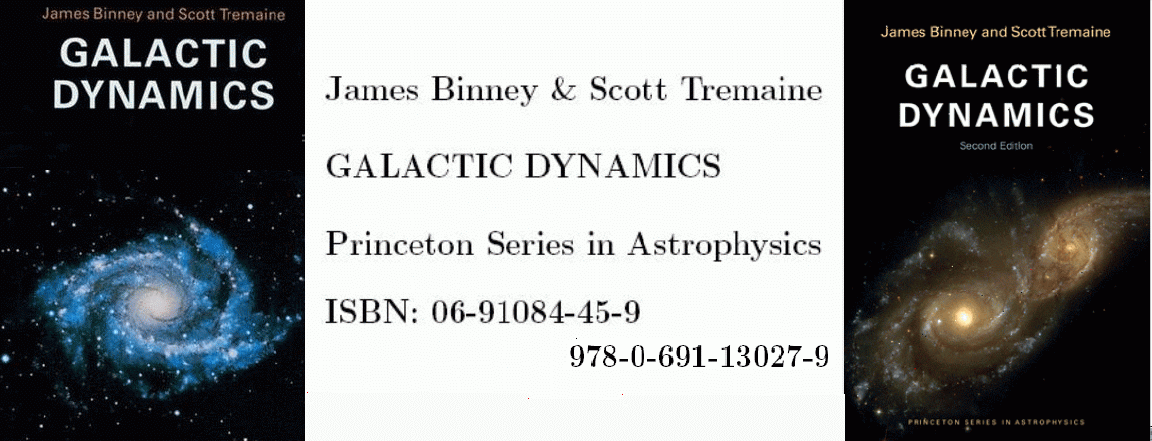
 Sterren( en melkweg)stelsels
This a lecture course (in Dutch) on "stars and galaxies" for first-year students
that I gave for the first time in 2007 and for the last time in
2009. It is also known as the course
"Sterrenstelsels" and for the most part follows my original course
Introductory
Astronomy.
Sterren( en melkweg)stelsels
This a lecture course (in Dutch) on "stars and galaxies" for first-year students
that I gave for the first time in 2007 and for the last time in
2009. It is also known as the course
"Sterrenstelsels" and for the most part follows my original course
Introductory
Astronomy.
Here are pdf-files of the lecture presentations:
1.
Eigenschappen van sterren: Hertzsprung--Russell diagram
2.
Interstellar medium en stervorming
3.
Sterevolutie en afstandbepaling
4.
Eindstadia van sterren
5.
Structuur en dynamica van ons Melkwegstelsel
6.
Melkwegstelsels
7.
Kosmologie
Het boek bij het college is voor raadpleging:

De tentamenstof is gedefinieerd aan de hand van
bovenstaande presentaties en is dat wat behandeld is op college.
 Structure and dynamics of galaxies
Structure and dynamics of galaxies
This is a 24-lecture
course I gave in September 2011 for Master and graduate students at
the Graduate University of the Chinese Academy of Science and of Peking
University in Beijing, China. It is a merger of the two advanced lecture
courses above, but somewhat updated.
The presentations can be downloaded as one large pdf-file
(26.9 Mb) or for each lecture separately. In the latter case you download the first lecture
and then replace `Beijing01.pdf' in the URL with `Beijingnn.pdf' with
nn from 02 to 24.
Back to contents
Back to top of page
Minor Planet 10437 van der Kruit (6085 P-L)
On July 5, 2001 the International Astronomical
Union announced that it has named minor planet (or asteroid)
6085P-L after me. The orbital elements of
10437 van der Kruit
are a semi-major axis of 2.3690 Astronomical Units
(1 A.U. is about 150,000,000 km), an excentricity of
0.2248 and an inclination of 1.779 degrees. The orbital
period around the Sun is then 3.65 years.
The closest it will get to the Earth is about 125 million
kilometers. Upcoming near approaches are September 4, 2011 (0.868 AU or 130
million km), July 12, 2029 (0.882 AU or 132 million km) and July 24, 2040 (0.838
AU or 126 million km).
The diameter is unknown,
but judging from its brightness it should be
about 5 km or so.
Here is the orbit and the position
on two dates roughly half a year apart.
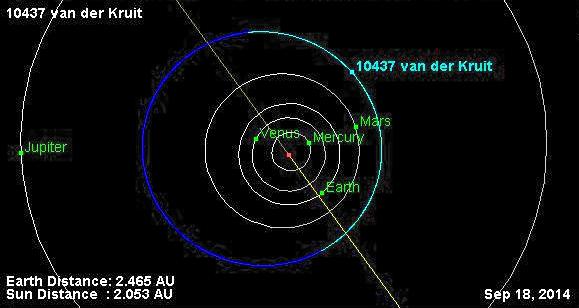
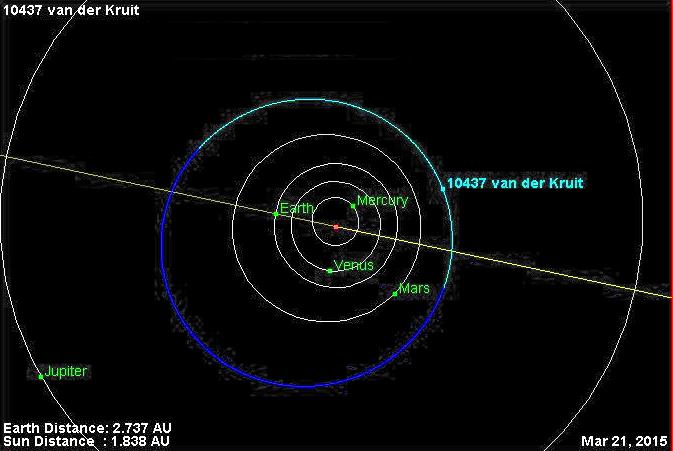
These
pictures have been produced using https://neo.jpl.nasa.gov/orbits/
. This site is set up for so-called
Near-Earth Objects (NEO's),
which are minor planets that in
their orbits may come very close to Earth.
The orbits are bright lines when above
that of the Earth and darker when below. The planets and minor planet
move in this representation clockwise. The slanted
yellow line shows the directions of the equinoxes.
The current position on the sky
with respect to the stars and constellations can be found using
Your Sky.
The orbit of the Earth
(and the planets, minor planetss and comets) is elliptical.
The aphelion (point furthest
from the Sun) is about 4% further from the Sun than the perihelion
(closest point). The Earth is in perihelion early January (usually
between 2 and 5 January) and in aphelion early July (usually between
3 and 7 July). The equinoxes (when day and night are equal) are on
20 or 21 March and on 22 or 23 September and the solstices (when day
or night are longest) on 20 or 21 June and on 21 or 22 December. A
listing of ap- and perihelion passages, equinoxes and solstices between
1992 and 2020 can be found at the U.S. Naval Observatory.
The distances in the Solar System are in Astronomical Units (AU), which is the
mean distance between the Earth and the Sun; it is about 150 million km or
about 8.3 lightminutes.
The site above at JPL can also be used to view where comets are in their orbits.
Here is a recent position of Comet Halley in
projections
face-on
and
edge-on
to the Earth's orbit. In the face-on view the comet moves
anti-clockwise (retrograde with respect to the planets, that move clockwise).
Minor planetss are large number of small bodies
moving between the orbits of Mars and Jupiter. The largest (discovered on
the first day of the 19-th century: January 1, 1801) has
Ceres, which is a spherical body with a
radius of about 475 km.
In very recent times a number of large bodies have been discovered in the
outer Solar System in the so-called Kuiper Belt.
Some of these are comparable in size to the Pluto (diameter 2320 km).
One (Eris) is even larger than Pluto (see the story of the discoverer
Mike Brown
). Including
Pluto and its moon
Charon, there are now at least 11 objects with
diameters definitely or possibly larger than 1000 km. It is fun to use the
JPL/NEO site to look at their orbits.
Some designations (or names when the IAU
has assigned these) are
Eris,
Haumea,
Makemake,
Sedna,
Orcus,
Quaoar,
Ixion,
2002 AW197 and
Varena.
During the 2006 General Assembly of the International Astronomical Union
in Prague
the astronomical definition of a planet has
been adopted. The Website of the I.A.U.
gives more details. I have voted for
Resolution 5,
since Pluto is definitely a different kind of object than the other
eight (major) planets, and I have voted against Resolution 6, sincs I felt it was
unnecessary.
The organisors of the Prague IAU General Assembly have a
site with electronic copies (and electronic supplements)
of their daily conference newspaper,
"Dissertatio cum Nuncio Sidereo, Series Tertia". Many aspects of the
sometimes heated discussions in Prage have been recorded there.
Back to contents
Back to top of page
Distinguished professorship
On 22 December 2003 the University
named three of its professorships in the Faculty of Mathematics
and Natural Sciences after famous scientists. This was
to honor the three persons that occupied those chairs, who
according to the Faculty have `extraordinary scientific qualifications'
and could be considered to be top scientists within the Faculty.
I was one of the three that were selected and was appointed
as Jacobus C. Kapteyn
Distinguished Professor of Astronomy. The other two were Serge Daan (Nikolaas Tinbergen
Distinguisehd Professor of Ethology) and Ben Feringa (Jacobus H. van 't Hoff
Distinguished Professor of Organic Chemistry).

Here is the press
release (in Dutch), pictures from the ceremony
and the text of my presentation
at that occasion.
My former graduate students decided to celebrate this with a special
symposium
in my
honor, which was held July 3 - 8, 2005 at the Frisian island of Terschelling.
The
homepage
of the symposium has more information, including electronic versions of many of the
presentations (such as the conference summary
by Tim de Zeeuw) and photographs.
Here are the group
picture of the conference and the picture of me with a few of my (former) graduate
students that were present.
There is a set of photographs taken by Stephane Courteau
and a set by myself.
The proceedings have been edited by Roelof de Jong and published by Springer.
The following links are to the
title page, preface etc. , to the
introductory review by Ken Freeman and to the
Conference summary by Tim de Zeeuw.
Back to contents
Back to top of page
Royal Decoration
At the occasion of the Queen's Birthday (celebrated traditionally on April 30)
in 2006 I was awarded a Royal decoration
"Ridder in de Orde van de Nederlandse Leeuw"
(Knight
in the Order of the Netherlands Lion) for my
"work in the scientific field and management activities for the
University of Groningen, ASTRON, ESO, NOVA, NCA
and many other organizations". This is a special distinction for people with
"merits of a very exceptional nature for society"; of the well over
3000 royal distinctions awarded
annually at this occasion usually only 10 to 15 are in the
Order
of the Netherlands Lion. All others are in the Order of
Orange-Nassau for people "who have earned special merits for society".
Here is the university's press
release (in Dutch). Since I was at that time in
the U.S., I received this decoration on Thursday 13th July 2006 from the
Mayor of Groningen, Jacques Wallage, during a visit he made to the
Kapteyn Astronomical Institute. This was announced in this press
release (in Dutch). Here are some
photo's
of that occasion.
Back to contents
Back to top of page
In the air
After having been Dean of the Faculty of Mathematics
and Natural Sciences from September 1994 to December
1997, one of the presents I was given was a tandem
parachute jump at Eelde
Airport, which is located about 10 km south
of the center of Groningen.
I made the jump on March 21, 1998. We jumped out of the
aircraft at about 7000 feet and made a free fall of almost 30 seconds.
The picture below and these
are frames from a video recording that
was made with a recorder on the helmet of another person during the free fall.
We landed safely right at the center of the
target
in the middle of the field.

Back to contents
Back to top of page
Koninklijk Natuurkundig Genootschap

The Royal Natural Sciences Society at Groningen
(Koninklijk
Natuurkundig Genootschap), of which
I am chairman of the Board, organizes monthly meetings (Tuesday
evenings from October to April) with scientific presentations.
These are held in the Concerthuis, Poelstraat 30 at Groningen,
of which the KNG is the owner. These are open to anyone interested.
Usually these presentations are held in Dutch.
In addition each year on the afternoon of the
second Sarurday of January, the KNG organizes a Symposium on
the Nobel Prizes in Physics, Chemistry and Physiology that have been
awarded the previous December. This is usually held in the Academic
Hospital in Groningen.
The KNG also awards every December the van Swinderenprijs
for the best Dutch summary in a Ph.D. thesis in
the foregoing academic year in the Faculties of Mathematics
and Natural Sciences and of Medical Sciences. These can
be nominated before the end of August by the author himself
or the thesis-supervisor. A copy if the thesis is required.
The annual membership fee is 10 Euro.
Membership forms
are available on the Website.
The program for the
current year is here.
The Society celebrated its 200-th anniversity in 2001
with a one-day Symposium with the title "Evolution
from Large to Small" in ``De Oosterpoort'', the
music and conference center of Groningen, on Saturday June
9, 2001. The program is here
. At the same occasion a commemorative
book has been
published with the title "Een Spiegel der Wetenschap:
200 jaar Koninklijk Natuurkundig Genootschap te Groningen".
Here are some pictures of the symposium: Board members
doing the last preparations, guests
in the audience, Loek
Hermans, Minister of Education, Culture
and Science (who I present the first copy of the
book), and the speakers Virginia
Trimble, Simon
Conway Morris, Paul
Crutzen, Leena
Peltonen and Piet Borst.
Back to contents
Back to top of page
Earth at night
Here is a spectacular picture of the
Earth at night; for a high-res picture click
here.

For a more recent (2012) version click
here.
Back to contents
Back to top of page
Powers of Ten
Bruce Bryson
has produced a beautiful version of the well-know
Powers of Ten
series of pictures on a dedicated
Website.
Each picture zooms in by a factor ten in linear size from the picture
in the top-left corner in the composite below with a diameter of
10 to the power 26 meters down to the lower-right corner at 10 to the
power -16 meters.
.
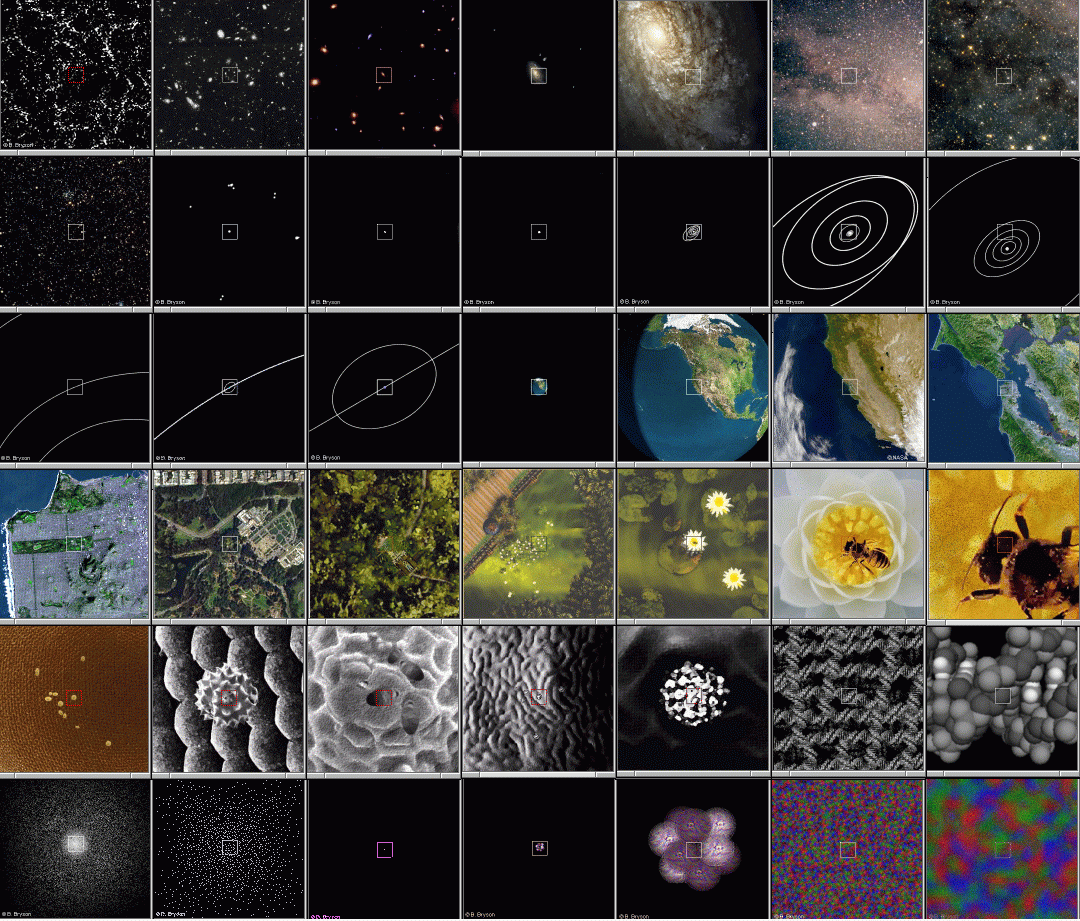
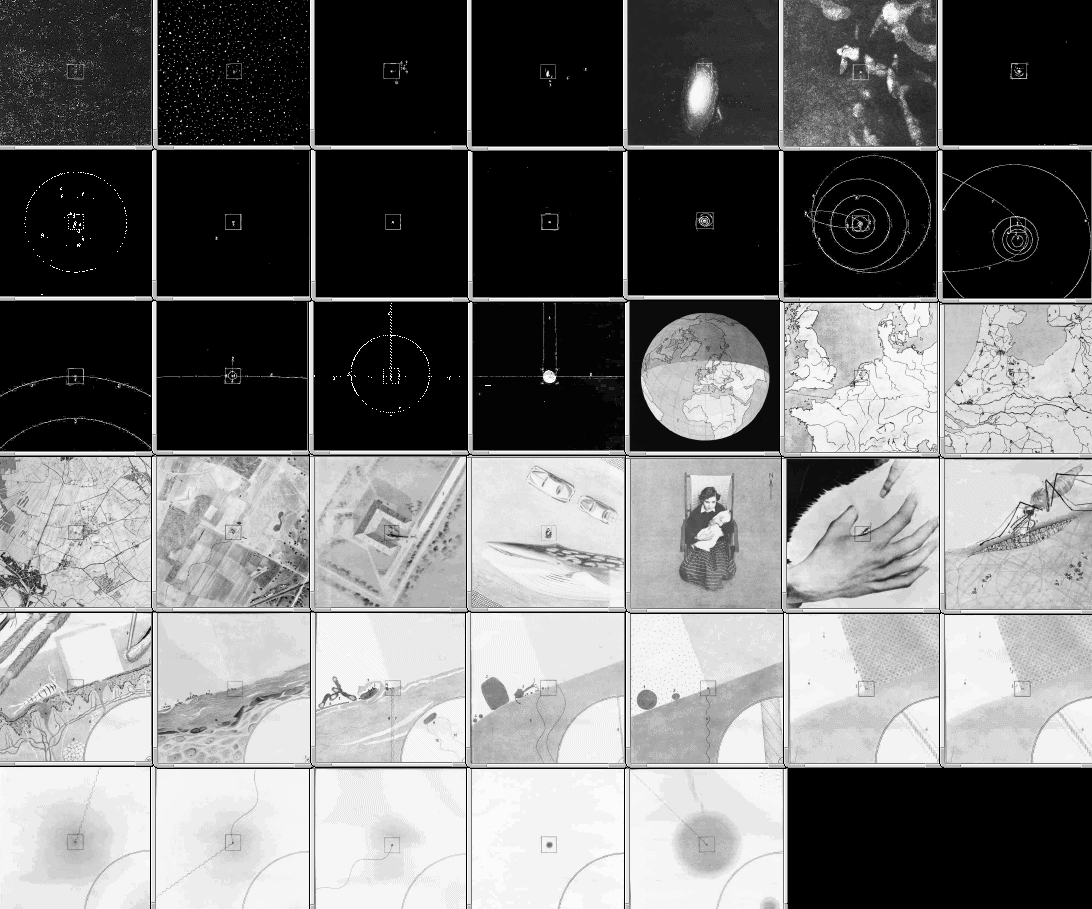
The idea originally came from a Dutch civil engineer and elementary school
teacher,
Kees Boeke (1884-1966), who lived in
Bilthoven.
He published his version in Dutch in 1952;
it was issued in English as
"Cosmic Views"
in 1957. The second mosaic shows Boeke's version.
This version can be found via Bryson's Website but also
here.
Back to contents
Back to top of page
Astronomical and Related Services and Literature
Organisations
-
 NOVA
NOVA
-
 NOVA (Leiden site)
NOVA (Leiden site)
-
 Vereniging van Samenwerkende Nederlandse
Universiteiten (VSNU)
Vereniging van Samenwerkende Nederlandse
Universiteiten (VSNU)
-
 Netherlands Organisation for Scientific
Research (NWO)
Netherlands Organisation for Scientific
Research (NWO)
-
 Royal Academy of Arts and Sciences (KNAW)
Royal Academy of Arts and Sciences (KNAW)
-
 Ministerie van Onderwijs, Cultuur en
Wetenschappen
Ministerie van Onderwijs, Cultuur en
Wetenschappen
-
 International Astronomical Union
International Astronomical Union
-
 Astronomy resources on
the Internet maintained at Centre de
Donnes astronomiques de Strasbourg
Astronomy resources on
the Internet maintained at Centre de
Donnes astronomiques de Strasbourg
-
 List of
Astronomy meetings
List of
Astronomy meetings
-
 List of Astronomy
meetings.
List of Astronomy
meetings.
-
 The STScI Digitized Sky Survey
The STScI Digitized Sky Survey
-
 Search for ExtraTerrestrial Intelligence
(SETI)
Search for ExtraTerrestrial Intelligence
(SETI)
-
 Centre for Science
and Technology Studies
Centre for Science
and Technology Studies
Publications
-
 Sloan Digital Sky Survey
Sloan Digital Sky Survey
-
 NASA Astrophysics Data
System (Harvard site)
NASA Astrophysics Data
System (Harvard site)
-
 NASA Astrophysics Data
System (ESO site)
NASA Astrophysics Data
System (ESO site)
-
 Astro-ph Preprint Server
Astro-ph Preprint Server
-
 The Astrophysical Journal
The Astrophysical Journal
-
 The Astronomical
Journal
The Astronomical
Journal
-
 Monthly
Notices of the Royal Astronomical Society
Monthly
Notices of the Royal Astronomical Society
-
 Astronomy
& Astrophysics
Astronomy
& Astrophysics
-
 Publications
of the Astronomical Society of the Pacific
Publications
of the Astronomical Society of the Pacific
-
 Nature
Nature
-
 Science
Science
-
 Scientific American
Scientific American
-
 New Scientist
New Scientist
-
 Sky & Telescope
Sky & Telescope
-
 Zenit
Zenit
-
Observatories
-
 Netherlands Foundation for Research
in Astronomy (NFRA)
Netherlands Foundation for Research
in Astronomy (NFRA)
-
 La Palma (Isaac Newton
Group of Telescopes)
La Palma (Isaac Newton
Group of Telescopes)
-
 European Southern Observatory
(ESO)
European Southern Observatory
(ESO)
-
 Mount Stromlo Observatory
Mount Stromlo Observatory
-
 Mount Stromlo and
Siding Spring Observatories
Mount Stromlo and
Siding Spring Observatories
-
 Carnegie Observatories
Carnegie Observatories
-
 Space Telescope Science Institute
Space Telescope Science Institute
-
 Space Telescope - European
Coordinating Facility (ST-ECF)
Space Telescope - European
Coordinating Facility (ST-ECF)
-
 Canada-France-Hawaii Telescope
Canada-France-Hawaii Telescope
-
 European Space Agency
- Space Science
European Space Agency
- Space Science
-
 James Clerk Maxwell Telescope
(JCMT)
James Clerk Maxwell Telescope
(JCMT)
-
 National Optical Astronomy Observatories
(NOAO)
National Optical Astronomy Observatories
(NOAO)
-
 National Radio Astronomy Observatory
(NRAO)
National Radio Astronomy Observatory
(NRAO)
-
 The Australia Telescope
National Facility (ATNF)
The Australia Telescope
National Facility (ATNF)
-
 Cambridge Institute of Astronomy
Cambridge Institute of Astronomy
-
 Royal Observatory Edinburgh (ROE)
Royal Observatory Edinburgh (ROE)
-
 European Science and Technology
Research
European Science and Technology
Research
-
Back to contents
Back to top of page
The galaxy below is my favorite; it is called NGC 891.
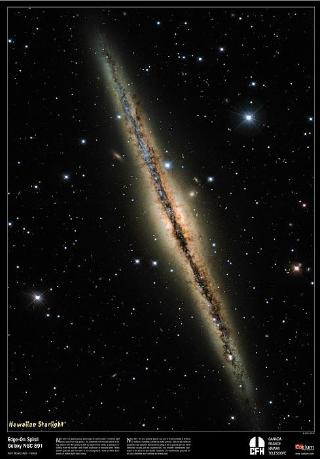 Back to contents
Back to top of page
Back to contents
Back to top of page



